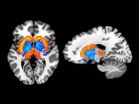(Press-News.org) AUGUSTA, Ga. – The same sex hormone that helps protect females from stroke may also reduce their risk of autism, scientists say.
In the first look at a potential role of the female sex hormone in autism, researchers at the Medical College of Georgia at Georgia Regents University have found expression of estrogen receptor beta – which enables estrogen's potent brain protection – is significantly decreased in autistic brains. The receptor also plays a role in locomotion as well as behavior, including anxiety, depression, memory, and learning.
"If you ask any psychiatrist seeing patients with autistic behavior their most striking observation from the clinic, they will say there are more males compared to females," said Dr. Anilkumar Pillai, MCG neuroscientist and corresponding author of the study in Molecular Autism.
Estrogen is known to help protect premenopausal women from maladies such as stroke and impaired cognition. Exposure to high levels of the male hormone testosterone during early development has been linked to autism, which is five times more common in males than females.
The new findings of reduced expression of estrogen receptor beta as well as that of an enzyme that converts testosterone to estrogen could help explain the high testosterone levels in autistic individuals and higher autism rates in males, Pillai said.
It was the 5-to-1 male-to-female ratio along with the testosterone hypothesis that led Pillai and his colleagues to pursue whether estrogen might help explain the significant gender disparity and possibly point toward a new treatment.
"The testosterone hypothesis is already there, but nobody had investigated whether it had anything to do with the female hormone in the brain," Pillai said. "Estrogen is known to be neuroprotective, but nobody has looked at whether its function is impaired in the brain of individuals with autism. We found that the children with autism didn't have sufficient estrogen receptor beta expression to mediate the protective benefits of estrogen."
Comparing the brains of children with and without autism spectrum disorder, the researchers found a 35 percent decrease in estrogen receptor beta expression as well as a 38 percent reduction in the amount of aromatase, the enzyme that converts testosterone to estrogen.
Levels of estrogen receptor beta proteins, the active molecules that result from gene expression and enable functions like brain protection, were similarly low. There was no discernable change in expression levels of estrogen receptor alpha, which mediates sexual behavior.
The study focused on the brain's prefrontal cortex, which is involved in social behavior and cognition. Brain tissue from both autistic and healthy subjects was obtained from the Eunice Kennedy Shriver National Institute of Child Health and Human Development Brain and Tissue Bank for Developmental Disorders at the University of Maryland. The children died at an average age of 11 from drowning, other accidents, or suicide. All the brain tissue was from male children except for one control.
While much work remains, estrogen receptor beta agonists, which are already known to improve brain plasticity and memory in animals, might one day help reverse autism's behavioral deficits, such as reclusiveness and repetitive behavior, Pillai said.
The scientists already are moving to animal studies to see what happens when they reduce estrogen receptor beta expression in mice. They also plan to give an estrogen receptor beta agonist – which should increase receptor function – to a mouse with generalized inflammation and signs of autism to see if it mitigates those signs. Inflammation is a factor in many diseases of the brain and body, and estrogen receptor beta agonists already are in clinical trials for schizophrenia
Larger, follow-up studies should also include comparing expression of testosterone receptor levels in healthy and autistic children, Pillai said. MCG scientists also want to know more about why the reduced beta receptor expression occurs.
Studies published in the journal Molecular Psychiatry earlier this year by scientists at the University of Cambridge and Denmark's Statens Serum Institute showed that male children who develop autism were exposed to higher levels of steroid hormones, including testosterone and progesterone, during development than their healthy peers.
The incidence of autism has increased about 30 percent in the past two years in the United States, to the current rate of about 1 in 68 children, according to the Centers for Disease Control and Prevention. Most children are diagnosed at about age 4, although the disorder can be diagnosed by about age 2, according to the CDC. Diagnosis is made through extensive behavioral and psychological testing.
INFORMATION:
GRU graduate student Amanda Crider is first author on the study.
Toni Baker
Communications Director
Medical College of Georgia
Georgia Regents University
706-721-4421 Office
706-825-6473 Cell
tbaker@gru.edu
Estrogen receptor expression may help explain why more males have autism
2014-09-09
ELSE PRESS RELEASES FROM THIS DATE:
Phosphorus a promising semiconductor
2014-09-09
Defects damage the ideal properties of many two-dimensional materials, like carbon-based graphene. Phosphorus just shrugs.
That makes it a promising candidate for nano-electronic applications that require stable properties, according to new research by Rice University theoretical physicist Boris Yakobson and his colleagues.
In a paper in the American Chemical Society journal Nano Letters, the Rice team analyzed the properties of elemental bonds between semiconducting phosphorus atoms in 2-D sheets. Two-dimensional phosphorus is not theoretical; it was recently created ...
A system that facilitates malware identification in smartphones
2014-09-09
Malware is a type of malicious program whose general aim is to profit economically by carrying out actions without the user's consent, such as stealing personal information or committing economic fraud. We can find it "in any type of device ranging from traditional cell phones to today's smartphones, and even in our washing machine," explained one of the researchers, Guillermo Suarez de Tangil, from the Computer Science Department at UC3M.
With the massive sales of smartphones in recent years (more than personal computers in all of their history), malware developers ...
Testing the fossil record
2014-09-09
Palaeontologists have developed methods to try to identify and correct for bias and incompleteness in the fossil record. A new study, published on 4 September 2014 in the journal Nature Communications, suggests that some of these correction methods may actually be misleading. The work is led by Dr Alex Dunhill (University of Leeds, formerly at the Universities of Bath and Bristol), together with Hannisdal (University of Bergen) and Professor Michael Benton (University of Bristol).
Back to the origin of animals
"The Earth keeps changing. Life keeps evolving. And there ...
How age alters our immune response to bereavement
2014-09-09
Young people have a more robust immune response to the loss of a loved one, according to new research from the University of Birmingham, providing insight into how different generations cope with loss.
The study, published in the journal Immunity and Ageing, shows how the balance of our stress hormones during grief changes as we age – meaning elderly people are more likely to have reduced immune function and, as a result, suffer from infections.
It is the first research to compare different generations and display the relationship between stress hormones and immune ...
Myriad myPath™ melanoma test reduced indeterminate cases by 76 percent
2014-09-09
SALT LAKE CITY, Utah, Sept. 9, 2014 – Myriad Genetics, Inc. (Nasdaq: MYGN) today presented results from a pivotal clinical utility study of the Myriad myPath™ Melanoma test at the 2014 College of American Pathologists (CAP) annual meeting in Chicago, Ill. Myriad myPath Melanoma is a novel diagnostic test that differentiates malignant melanoma from benign skin lesions with greater than 90 percent accuracy and helps physicians deliver a more objective and confident diagnosis for patients.
This study evaluated the impact of the myPath Melanoma diagnostic test on expert ...
Biologists try to dig endangered pupfish out of its hole
2014-09-09
Berkeley — Scientists estimate that fewer than 100 Devils Hole pupfish remain in their Mojave Desert home, but a conservation biologist at the University of California, Berkeley, is giving important guidance in the efforts to rescue them by establishing a captive breeding program.
Considered the world's rarest fish, with one of the smallest geographic ranges of any wild vertebrate, the tiny pupfish (Cyprinodon diabolis) – about one-inch long as an adult – neared extinction in spring 2013 when populations dropped to an all-time low of 35 observable pupfish. While more ...
Tracing water channels in cell surface receptors
2014-09-09
G protein-coupled receptors (GPCRs) are the largest class of cell surface receptors in our cells, involved in signal transmission across the cell membrane. One of the biggest questions is how a signal recognized at the extracellular side of a GPCR induces a sequence of conformational changes in the protein and finally evokes an intracellular response. EPFL scientists have now used computer modeling to reveal in molecular detail the structural transitions that happen inside GPCRs during the signal transduction process. They discovered that a central step in the trans-membrane ...
Shift in Arabia sea plankton may threaten fisheries
2014-09-09
A growing "dead zone" in the middle of the Arabian Sea has allowed plankton uniquely suited to low-oxygen water to take over the base of the food chain. Their rise to dominance over the last decade could be disastrous for the predator fish that sustain 120 million people living on the sea's edge.
Scientists at Columbia University's Lamont-Doherty Earth Observatory and their colleagues are the first to document the rapid rise of green Noctiluca scintillans, an unusual dinoflagellate that eats other plankton and draws energy from the sun via microscopic algae living within ...
Buckyballs and diamondoids join forces in tiny electronic gadget
2014-09-09
Menlo Park, Calif. — Scientists have married two unconventional forms of carbon – one shaped like a soccer ball, the other a tiny diamond – to make a molecule that conducts electricity in only one direction. This tiny electronic component, known as a rectifier, could play a key role in shrinking chip components down to the size of molecules to enable faster, more powerful devices.
"We wanted to see what new, emergent properties might come out when you put these two ingredients together to create a 'buckydiamondoid,'" said Hari Manoharan of the Stanford Institute for Materials ...
Eating habits, body fat related to differences in brain chemistry
2014-09-09
People who are obese may be more susceptible to environmental food cues than their lean counterparts due to differences in brain chemistry that make eating more habitual and less rewarding, according to a National Institutes of Health study published in Molecular Psychiatry.
Researchers at the NIH Clinical Center found that, when examining 43 men and women with varying amounts of body fat, obese participants tended to have greater dopamine activity in the habit-forming region of the brain than lean counterparts, and less activity in the region controlling reward. Those ...






